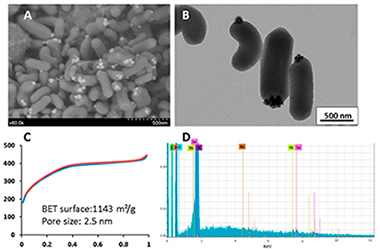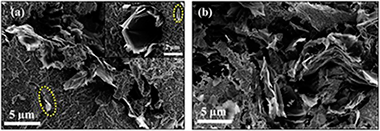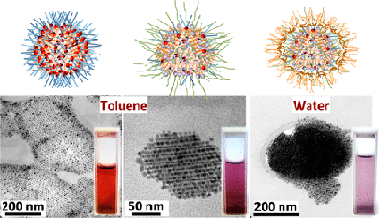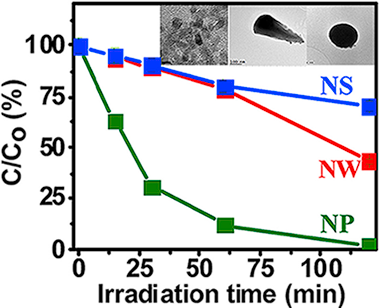Artículos SCI
2019
2019
Materiales Coloidales
Encapsulation of Upconversion Nanoparticles in Periodic Mesoporous Organosilicas
Rahmani, S; Jimenez, CM; Aggad, D; Gonzalez-Mancebo, D; Ocana, M; Ali, LMA; Nguyen, C; Nieto, AIB; Francolon, N; Oliveiro, E; Boyer, D; Mahiou, R; Raehm, L; Gary-Bobo, M; Durand, JO; Charnay, CMolecules, 24 (2019) 22
Show abstract ▽

(1) Background: Nanomedicine has recently emerged as a promising field, particularly for cancer theranostics. In this context, nanoparticles designed for imaging and therapeutic applications are of interest. We, therefore, studied the encapsulation of upconverting nanoparticles in mesoporous organosilica nanoparticles. Indeed, mesoporous organosilica nanoparticles have been shown to be very efficient for drug delivery, and upconverting nanoparticles are interesting for near-infrared and X-ray computed tomography imaging, depending on the matrix used. (2) Methods: Two different upconverting-based nanoparticles were synthesized with Yb3+-Er3+ as the upconverting system and NaYF4 or BaLuF5 as the matrix. The encapsulation of these nanoparticles was studied through the sol-gel procedure with bis(triethoxysilyl)ethylene and bis(triethoxysilyl)ethane in the presence of CTAB. (3) Results: with bis(triethoxysilyl)ethylene, BaLuF5: Yb3+-Er3+, nanoparticles were not encapsulated, but anchored on the surface of the obtained mesoporous nanorods BaLuF5: Yb3+-Er3+@Ethylene. With bis(triethoxysilyl)ethane, BaLuF5: Yb3+-Er3+ and NaYF4: Yb3+-Er(3+)nanoparticles were encapsulated in the mesoporous cubic structure leading to BaLuF5: Yb3+-Er3+@Ethane and NaYF4: Yb3+-Er3+@Ethane, respectively. (4) Conclusions: upconversion nanoparticles were located on the surface of mesoporous nanorods obtained by hydrolysis polycondensation of bis(triethoxysilyl)ethylene, whereas encapsulation occurred with bis(triethoxysilyl)ethane. The later nanoparticles NaYF4: Yb3+-Er3+@Ethane or BaLuF5: Yb3+-Er3+@Ethane were promising for applications with cancer cell imaging or X-ray-computed tomography respectively.
Noviembre, 2019 | DOI: 10.3390/molecules24224054
Reactividad de Sólidos
Graphene nanoplatelets for electrically conductive 3YTZP composites densified by pressureless sintering
Lopez-Pernia, C; Gallardo-Lopez, A; Morales-Rodriguez, A; Poyato, RJournal of the European Ceramic Society, 39 (2015) 4435-4439
Show abstract ▽

3 mol% yttria tetragonal zirconia polycrystalline (3YTZP) ceramic composites with 2.5, 5 and 10 vol% graphene nanoplatelets (GNP) were pressureless sintered in argon atmosphere between 1350 and 1450 degrees C. The effects of the GNP content and the sintering temperature on the densification, microstructure and electrical properties of the composites were investigated. An isotropic distribution of GNP surrounding ceramic regions was exhibited regardless the GNP content and sintering temperature used. Electrical conductivity values comparable to the ones of fully dense composites prepared by more complex techniques were obtained, even though full densification was not achieved. While the composite with 5 vol% GNP exhibited electrical anisotropy with a semiconductor-type behaviour, the composite with 10 vol% GNP showed an electrically isotropic metallic-type behaviour.
Noviembre, 2019 | DOI: 10.1016/j.jeurceramsoc.2019.05.067
Nanotecnología en Superficies y Plasma
Kinetic energy-induced growth regimes of nanocolumnar Ti thin films deposited by evaporation and magnetron sputtering
Alvarez, R.; Garcia-Valenzuela, A.; Rico, V; Garcia-Martin, J. M.; Cotrino, J.; Gonzalez-Elipe, A. R.; Palmero, A.Nanotechnology, 30 (2019) 475603
Show abstract ▽
We experimentally analyze different growth regimes of Ti thin films associated to the existence of kinetic energy-induced relaxation mechanisms in the material's network when operating at oblique geometries. For this purpose, we have deposited different films by evaporation and magnetron sputtering under similar geometrical arrangements and at low temperatures. With the help of a well-established growth model we have found three different growth regimes: (i) low energy deposition, exemplified by the evaporation technique, carried out by species with typical energies in the thermal range, where the morphology and density of the film can be explained by solely considering surface shadowing processes, (ii) magnetron sputtering under weak plasma conditions, where the film growth is mediated by surface shadowing mechanisms and kinetic-energy-induced relaxation processes, and (iii) magnetron sputtering under intense plasma conditions, where the film growth is highly influenced by the plasma, and whose morphology is defined by nanocolumns with similar tilt than evaporated films, but with much higher density. The existence of these three regimes explains the variety of morphologies of nanocolumnar Ti thin films grown at oblique angles under similar conditions in the literature.
Noviembre, 2019 | DOI: 10.1088/1361-6528/ab3cb2
Materiales Coloidales
Monodisperse Gold Cuboctahedral Nanocrystals Directly Synthesized in Reverse Micelles: Preparation, Colloidal Dispersion in Organic Solvents and Water, Reversible Self-Assembly and Plasmonic Properties
Luna, C; Castaneda-Rodriguez, D; Barriga-Castro, ED; Nunez, NO; Mendoza-Resendez, RLangmuir, 34 (2019) 14291-14299
Show abstract ▽

The synthesis of organic-solvent-dispersible gold nanoparticles in reverse micelles of didodecyldimethylammonium bromide (DDAB) is revisited in the present investigation. Some parameters of synthesis, specifically the reaction volume and the concentration of the reducing agent, were slightly modified obtaining directly monodisperse gold nanocrystals (AuNCs) without the need to use additional active surfactants or additional treatments such as digestive ripening. Interestingly, most of the obtained AuNCs display the same exposed crystalline faces composed of six bounding facets (four {111} faces and two {002} faces), corresponding to single-crystalline face-centered cubic nanoparticles with a cuboctahedron shape. When these AuNCs are subsequently functionalized with 1-decanethiol (C10H21SH) or 1-dodecanethiol (C12H25SH), they don’t experience significant changes in their size or crystalline texture, however, they self-aggregate directly in the suspension at room temperature into faceted supramolecular structures and exhibit collective plasmonic excitations. Such self-organization is reversible under heating treatments allowing the observation of the influence of the AuNCs aggregation state on their plasmonic properties. Fourier transform infrared spectroscopy reveals that thiols only replace partially the DDAB molecules, and thus, DDAB molecules remain present in the thiol-capped AuNCs. To turn the thiol-capped nanocrystals into water-dispersible nanocrystals and extend their technological potential, they are stabilized with poloxamer 407 obtaining highly stable purple colloids in water.
Noviembre, 2019 | DOI: 10.1021/acs.langmuir.9b02374
Materiales Nanoestructurados y Microestructura
Morphological effects on the photocatalytic properties of SnO2 nanostructures
Kar, A; Olszowka, J; Sain, S; Sloman, SRI; Montes, O; Fernandez, A; Pradhan, SK; Wheatley, AEHJournal of Alloys and Compounds, 810 (2019) UNSP 151718
Show abstract ▽

The photocatalytic properties of SnO2 nanocrystals are tuned by varying their morphology and microstructure. SnO2 nanoparticles and nanowedges have been synthesized using hydrothermal methods, while microwave irradiation techniques have given nanospheres. Detailed structural and chemical characterization of these different morphologies has been accomplished. The influence of SnO2 morphology on photocatalytic activity has been examined by monitoring the degradation of aqueous methylene blue dye. Results demonstrate that changing the morphology of the SnO2 modulates both surface area and levels of surface defects and that these alterations are reflected in the photocatalytic properties of the materials. The degradation of methylene blue dye (98%) in the presence of SnO2 nanoparticles under simulated solar irradiation is superior to previously reported photocatalyst performance and is comparable to that of standard TiO2 (Degussa P-25). The SnO2 nanoparticles perform better than both the nanowedges and nanospheres and this is attributed to the number of surface defects available to the high surface area material. They also reveal outstanding recyclability and stability.
Noviembre, 2019 | DOI: 10.1016/j.jallcom.2019.151718
- ‹ anterior
- 112 of 410
- siguiente ›














